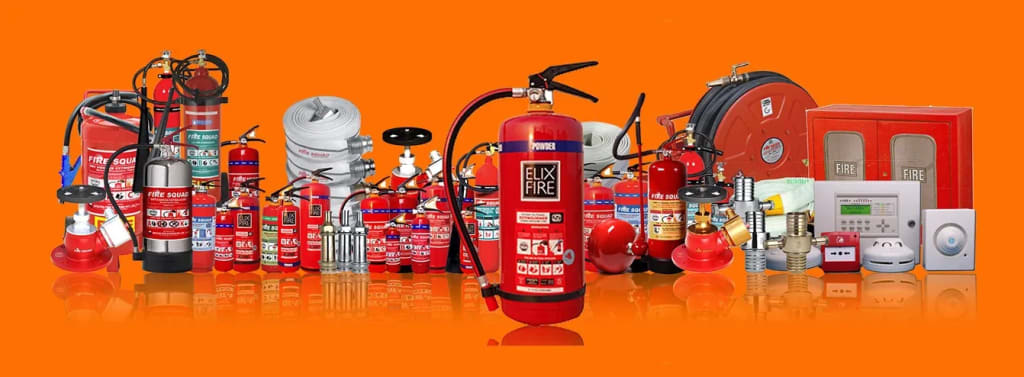Blog Post
What is Fire Fighting Equipment and Their Importance on Ship
Posted By: Harsh Bamnolia
Posted On : 15-Apr-2025

What is Fire Fighting Equipment and Their Importance on Ship
What is Fire Fighting Equipment: An Introduction
What is fire fighting equipment if not the backbone of shipboard safety? Fire fighting equipment refers to the tools, devices, and systems designed to detect, combat, and extinguish fires aboard a vessel.
In maritime environments, fire hazards are not just possible but probable due to engine operations, fuel storage, electrical systems, and other onboard machinery.
This makes the role of fire fighting equipment not just important, but mandatory as per global safety regulations like SOLAS (Safety of Life at Sea).
Marine fire fighting equipment can be broadly classified into portable, semi-portable, and fixed systems. Each type plays a crucial role in addressing different classes of fire and emergency scenarios.
Their effectiveness lies in early detection, suppression, and ensuring safe evacuation when required. Without such systems, the potential for catastrophic damage, environmental harm, or even loss of life significantly increases.
What is Fire Fighting Equipment Composed Of?
Understanding what is fire fighting equipment involves looking at its components. These are the most commonly used types of marine fire fighting systems and appliances found aboard vessels:
1. Fire Detection Systems
Smoke Detectors: Provide early warning by sensing airborne smoke particles.
Heat Detectors: Detect rapid changes in temperature indicating possible fire.
IR and UV Flame Detectors: Use light spectrum technology to identify flames in engine and cargo areas.
Fire Alarm Control Panels: Central monitoring units for all detection devices, triggering alerts and alarms.
2. Portable Fire Extinguishers
CO2 Extinguishers: Ideal for electrical fires.
Foam Extinguishers: Effective on flammable liquids (Class B fires).
Dry Chemical Extinguishers: Suitable for multiple fire types including Class A, B, and C.
Water-Based Extinguishers: Used for Class A fires (solid combustibles).
3. Fixed Fire Suppression Systems
CO2 Flooding Systems: Automatically release CO2 to suppress fire by displacing oxygen.
Foam-Based Systems: Create a foam blanket to cut off the fire's oxygen supply.
Water Mist Systems: Fine mist that cools the fire and suffocates it simultaneously.
Dry Powder Systems: Commonly used for chemical or electrical fires.
4. Fire Fighting Accessories
Fire Hoses & Nozzles: Direct high-pressure water to the fire's source.
Fire Pumps & Hydrants: Deliver pressurized water from ship’s tanks or the sea.
Emergency Escape Breathing Devices (EEBDs): For safe evacuation through smoke.
Self-Contained Breathing Apparatus (SCBA): Essential for crew members fighting fire directly.
5. Monitoring and Control Systems
Alarm & Monitoring Panels: Display real-time system alerts and fire location.
Emergency Shutoff Valves: Cut off fuel and ventilation supply in affected areas.
What is Fire Fighting Equipment's Role in Maritime Safety?
Fire can be one of the most devastating incidents onboard a ship. Unlike land-based buildings, ships operate in remote areas where immediate external assistance is not always available.
Hence, fire fighting equipment is the primary resource for detection, suppression, and rescue. Here’s why it matters:
1. Compliance with Global Maritime Standards
SOLAS regulations mandate every vessel to carry specific types of fire fighting equipment based on the vessel's type, size, and cargo. Not complying can result in detentions, fines, or even revocation of certifications.
2. Minimizing Fire Outbreaks
Immediate detection and suppression prevent fire from spreading across compartments, buying time for crew intervention or evacuation.
3. Protection of Human Life
From breathing apparatus to emergency escape systems, fire fighting equipment is directly linked to preserving lives during fire emergencies.
4. Safeguarding Cargo and Machinery
Fixed systems like CO2 or water mist systems protect the ship’s high-value areas like engine rooms, electrical panels, and fuel storage units.
5. Environmental Responsibility
Uncontrolled fires can result in oil spills or hazardous material release into the sea. Fire fighting systems help minimize this risk.
6. Enhanced Vessel Resale Value and Insurance Coverage
Well-maintained fire safety systems often lead to better insurance terms and increase the market credibility of the ship.
What is Fire Fighting Equipment Like at Marinetech?
Marinetech Safety & Shipping Corporation is a trusted name in providing SOLAS-compliant marine safety solutions. Our fire fighting equipment and services are trusted by shipowners, shipbuilders, and offshore platforms alike.
Their Product Line Includes:
Smoke Detectors for engine rooms and accommodation spaces.
IR and UV Flame Detectors built for quick-response environments.
Heat Detectors calibrated for kitchen and machinery areas.
Fire Alarm Panels with easy integration to vessel monitoring systems.
CO2, Foam, Water Mist, and Dry Powder Systems for fixed suppression.
SCBA and EEBD Units for crew safety.
Fire Hoses, Hydrants, and Nozzles for manual firefighting.
Marinetech Services:
Annual Inspection & Certification under Class & Flag guidelines.
System Installation & Retrofitting according to vessel design.
SCBA & EEBD Testing and Refilling.
Hydrostatic Cylinder Testing.
Control Panel & Alarm Diagnostics.
Each service comes with class-approved documentation, and onboard crew training is provided to ensure maximum efficiency.
Conclusion: Why Understanding What is Fire Fighting Equipment Matters
Understanding what is fire fighting equipment helps stakeholders onboard ships prepare for one of the most common and dangerous maritime risks—fire.
Every item, from detectors to extinguishers and alarm systems, works in harmony to ensure early detection, effective suppression, and secure evacuation.
Choosing reliable suppliers and service providers like Marinetech ensures compliance, functionality, and peace of mind. Our extensive product range and technical services make us your go-to partner for marine fire safety needs.
To explore or inquire about SOLAS-approved fire fighting equipment for your vessel, visit: https://marinetechss.com/supplies/fire-fighting-equipment-and-appliances